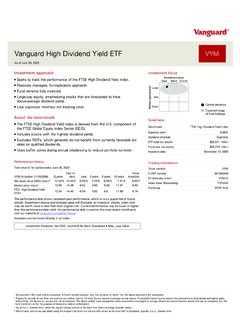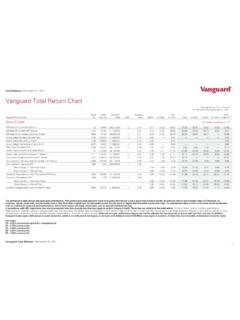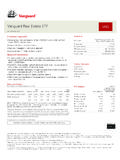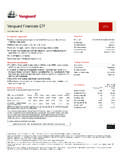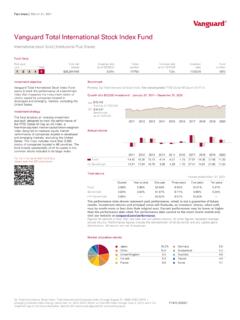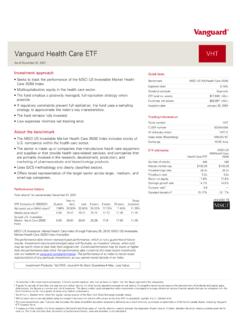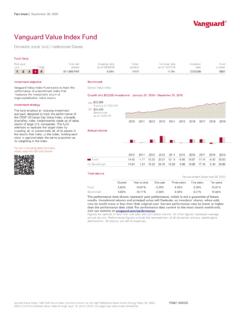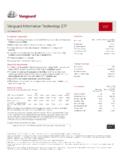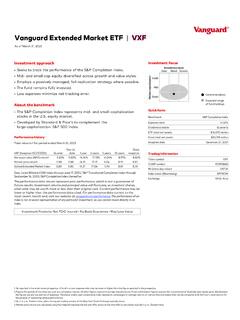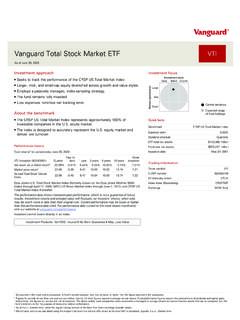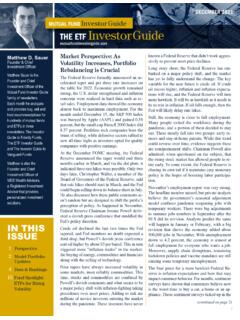Transcription of FTSE Emerging Markets ETF - The Vanguard Group
1 Vanguard Vanguard FTSE Emerging Markets ETF VWO As of December 31, 2021 Investment approach Seeks to track the performance of the FTSE Emerging Markets All Cap China A Inclusion Index. Passively managed, using index sampling. The fund invests substantially all of its assets in the stocks included in the index. About the benchmark The FTSE Emerging Markets All Cap China A Inclusion Index is a market-capitalization-weighted index representing large-,mid-, and small-cap stocks of companies located in Emerging Markets around the world. The index is part of the FTSE China A Inclusion indexes, which contain FTSE China A All Cap Index securities adjusted for the aggregate approved QFII and RQFII quotas available to foreign investors.
2 Brazil, Russia, India, Taiwan, China, and South Africa are among the Markets included in the index. Performance history Total returns 2 for period ended December 31, 2021 VWO (Inception 03/04/2005) Quarter Year to date 1 year 3 years 5 years 10 years Since inception Net asset value (NAV) return Market price return Spliced Emerging Markets Index Select Emerging Markets Index through August 23, 2006; MSCI Emerging Markets Index through January 9, 2013; FTSE Emerging Transition Index through June 27, 2013; FTSE Emerging Index through November 1, 2015; FTSE Emerging Markets All Cap China A Transition Index through September 18, 2016.
3 And FTSE Emerging Markets All Cap China A Inclusion Index thereafter. Benchmark returns are adjusted for withholding taxes. The performance data shown represent past performance, which is not a guarantee of future results. Investment returns and principal value will fluctuate, so investors shares, when sold, may be worth more or less than their original cost. Current performance may be lower or higher than the performance data cited. For performance data current to the most recent month-end, visit our website at . The performance of an index is not an exact representation of any particular investment, as you cannot invest directly in an index.
4 Investment Products: Not FDIC Insured No Bank Guarantee May Lose Value Quick facts Benchmark FTSE Emerging Markets All Cap China A Inclusion Index Expense ratio dividend schedule Quarterly ETF total net assets $81,078 million Fund total net assets $110,896 million Inception date March 4, 2005 Trading information Ticker symbol VWO CUSIP number 922042858 IIV (intra-day ticker) Index ticker (Bloomberg) FQEACR Exchange NYSE Arca ETF attributes FTSE Emerging Markets ETF FTSE Emerging Markets All Cap China A Inclusion Index Number of stocks 5,306 4,316 Median market cap $ $ Price/earnings ratio Price/book ratio Return on equity Earnings growth rate Equity yield ( dividend ) Turnover rate Standard deviation 6 1.
5 As reported in the most recent prospectus. A fund s current expense ratio may be lower or higher than the figure reported in the prospectus. 2. Figures for periods of less than one year are cumulative returns. All other figures represent average annual returns. Fund performance figures assume the reinvestment of dividends and capital gains distributions; the figures are pre-tax and net of expenses. The above widely used comparative index represents unmanaged or average returns on various financial assets that can be compared with the fund s total returns for the purpose of measuring relative performance. 3.
6 As of 4 , Eastern time, when the regular trading session of the New York Stock Exchange typically closes. 4. Market price returns are calculated using the midpoint between the bid and offer prices at the time NAV is calculated, typically 4 , Eastern time. 5. For most recent fiscal year. Turnover rate excludes the value of portfolio securities received or delivered as a result of in-kind purchases or redemptions of the fund s capital shares, including Vanguard ETF Creation Units. 6. A measure of the volatility of a fund based on the fund s last three years of monthly returns used to indicate the dispersion of past returns.
7 A higher standard deviation means a greater potential for volatility. For funds with less than 36 months of performance history, standard deviation is not calculated. Vanguard FTSE Emerging Markets ETF VWO As of December 31, 2021 Expense ratio comparison 1 Emerging Markets Funds Average Emerging Markets Fds Avg ETFs only FTSE Emerging Markets ETF Ten largest holdings and %of total net assets 2 Taiwan Semiconductor Manufacturing Co. Ltd. %Tencent Holdings Ltd. %Alibaba Group Holding Ltd. %Meituan %Reliance Industries Ltd. %Infosys Ltd. %China Construction Bank Corp. %MediaTek Inc. %Housing Development Finance Corp.
8 Ltd. %Vale SA %Top ten as %of total net assets Ten largest market allocations as %of common stock China %Taiwan %India %Brazil %South Africa %Saudi Arabia %Russia %Thailand %Mexico %Malaysia %Sector Diversification 3 Technology %Financials %Consumer Discretionary %Basic Materials %Industrials %Energy %Consumer Staples %Health Care %Telecommunications %Real Estate %Utilities %Other %1. Represents the expense ratio for the Vanguard ETF as reported in the most recent prospectus. There are material differences between mutual funds and ETFs. Unlike mutual funds, ETFs are priced continuously and bought and sold throughout the day in the secondary market (at a premium or discount to net asset value) with the assistance of a stockbroker, which entails paying commissions.
9 Sources: Lipper, a Thomson Reuters Company, and Vanguard , December 31, 2020. 2. The holdings listed exclude any temporary cash investments and equity index products. 3. Sector categories are based on the Industry Classification Benchmark system ( ICB ), except for the Other category (if applicable), which includes securities that have not been provided an ICB classification as of the effective reporting period. Vanguard ETF Shares are not redeemable with the issuing Fund other than in very large aggregations worth millions of dollars. Instead, investors must buy or sell Vanguard ETF Shares in the secondary market and hold those shares in a brokerage account.
10 In doing so, the investor may incur brokerage commissions and may pay more than net asset value when buying and receive less than net asset value when selling. All ETF products are subject to risk, which may result in the loss of principal. Investments in securities issued by companies are subject to risks including country/regional risk and currency risk. These risks are especially high in Emerging Markets . London Stock Exchange Group companies include FTSE International Limited ( FTSE ), Frank Russell Company ( Russell ), MTS Next Limited ( MTS ), and FTSE TMX Global Debt Capital Markets Inc. ( FTSE TMX ).
